DARN.. I wish I had done this last month when I had everything apart for the broken exhaust studs..
Last spring while out on the west coast I had an incident during a long steep climb, I was in 2nd gear turning about 4000 rpm. I was monitoring the temperature during the climb and watched as the heat gauge started climbing. I was anticipating the usual “woosh” as the fan clutch kicked in, but it didn’t happen.. I slowed the rpm’s down and at about 3400 rpm, the fan clutch started to kick in, and the temperature came down.
The original clutch seemed OK. It had some resistance when I turned the fan while it was cold. The new clutch had a lot more resistance. Rock Auto has it for $55 (GMB 9252090)
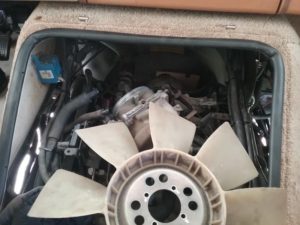
SEPARATING CLUTCH FROM WATER PUMP
Some of the auto parts stores will loan tools. In the past, I borrowed their fan clutch wrench set and used one of the wrenches to hold the pulley, and another to turn the large nut on the clutch. This time, instead of the auto store, I decided to make a wrench to hold the pulley, then used a regular ole pipe wrench to turn the large nut. NOTE – it may make it easier for the large wrench to hold the pulley if you loosen two of the pulley bolts.
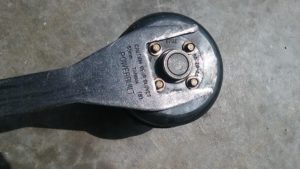
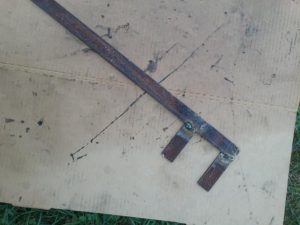
REMOVE
The fan/clutch won’t come out together as an assembly if the shroud is installed. Removing the shroud would involve draining the radiator and removing the lower hoses to get the shroud to drop down. I decided to see if I could get the clutch out by separating the fan and clutch, then pulling them out separately. It worked. I was able to unbolt the fan from the clutch, remove them, drop the new ones back into the shroud and reassemble them inside the shroud.
- Place a few small pieces of cardboard between the fan and the radiator. This will protect the radiator when the fan and clutch are removed.
- Bottom, loosen the four fan bolts on the clutch so they are finger tight.
- Bottom, loosen the fan clutch nut from the water pump shaft.
- Top, remove the air intake snorkel tube that runs between the air filter and throttle body.
- Top, remove the two top bolts that secure the fan shroud. This will allow the shroud to be moved up a couple inches
- Bottom, remove the fan clutch from the water pump, then separate the fan from the clutch by removing the four fan bolts.
- Top, there isn’t enough clearance to remove the clutch and fan from the bottom, So from the top I was able to pull the fan out first, then pull the clutch out.
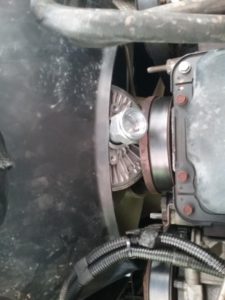
INSTALL
- Top, I lowered the clutch into the shroud, then lowered the fan into the shroud, make sure its pointing in the correct direction.
- Bottom, I mounted the fan to the clutch using the bolts, finger tight..
- Bottom, pull the belt tensioner and remove the serpentine belt from the power steering pulley. There’s no need to completely remove the belt. The goal here is to remove belt tension from the water pump pulley so we can turn the water pump pulley by hand..
- Top, Its almost impossible to rotate the clutch in order to get the clutch nut started, so instead, we’ll rotate the threaded water pump and get it to screw into the clutch nut. With one hand, hold the clutch nut up against the water pump threaded shaft. With the other hand rotate the water pump pulley to start the clutch nut onto the water pump shaft thread.
- Bottom, tighten the four bolts that hold the fan to the clutch.
- Bottom, tighten the fan clutch onto the water pump.
- Bottom, Reinstall the serpentine belt.
- Top, reinstall the two fan shroud bolts and the air intake snorkel tube.
- don’t forget to remove the cardboard pieces from the shroud.
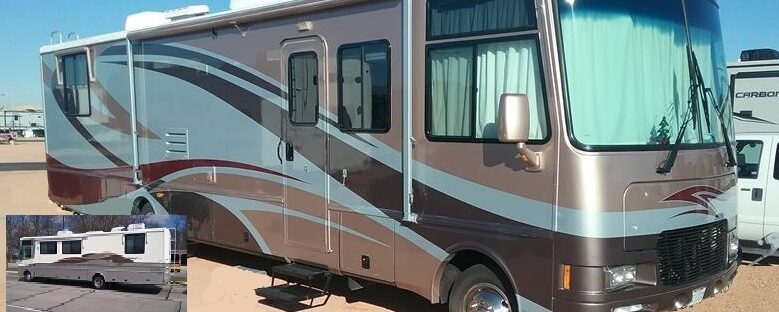
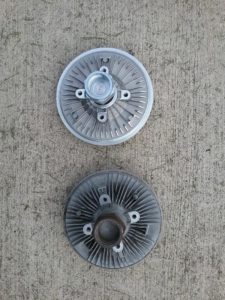
Pingback: Upgrade report – A little more power and better fuel economy – 1999 Southwind 35S
I did my brakes today. I also have a 32v southwind 1999. Basically just like yours. While i had the front tire off, I wanted to swap wheels with the 245×70 19.5 spare since it was a new Hankook. I went to 4 different tire shops trying to get it balanced. None of them had the proper adapter for the center of the wheel. I put glass beads in it and took off all the weights, smooth as glass now. And I caught the brakes as the last of the pad was fixing to be gone. I don’t want to do brakes again for a long time. My wheels are accuride #29236, If you find a source, let me know, I need one, If you come across a steering wheel vibration that comes and goes. it’s bent wheels. The front wheels never rotate at exactly the same rpm, as their runout matches and becomes 180 degrees apart eventually, that causes the vibration to come and go.
The mechanical fan won’t begin to kick in until the radiator discharge air reaches approximately 150F. If you thought the old one kicked on late it was likely because the ‘discharge air’ had not reached 150F. 150F is when the coil begins to tighten the temp will be higher than 150F discharge air once your hear the roar. Coolant temp and radiator discharge air temp don’t correlate with each other precisely the same.
The engine temp gauge was climbing and the clutch wasn’t kicking in. After I replaced the clutch, I noticed it kicks in significantly more often and the temperature gauge stays solid, doesn’t move. even on those hot uphill climbs.
I’m about to undertake the water pump project, so naturally I’m here thinking about my fan clutch.
I notice the only option offered for the F53 is the “severe duty” fan clutch. While I am all about overbuilding in anticipation of harsh conditions, I’m a little concerned with the comments I’ve seen talking about the constant noise and reduced fuel economy that some have experienced when they replaced their fan clutch (admittedly, some of those comments were about vehicles other than the F53).
Based on the really helpful pics you’ve posted, your new clutch looks pretty similar to the old one, and your fan blades have the deep 2.5 inch pitch that are nominally paired with a severe duty (or at least heavy duty) fan clutch.
So my question is, does the new clutch behave as you would have expected of the OEM clutch when it was fresh? I wouldn’t mind the fan engaging more often, but I’m certainly not looking for it to go full time, as some have experienced.